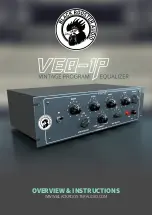
Page #1
INSTRUCTIONS FOR OPERATION OF ESOTERIC SOUND
RE-EQUALIZER
INTRODUCTION:
Tod ay's m od ern aud iop hile equip m en t ca n s om etim es be fru stratin g to ow ne rs of o ld re co rds, e sp ec ially
wh en the ir co llec tion includ es m an y old 78's o r old m on o Lp's . All m od ern pream ps are desig ne d s ole ly
for today's microgroove, RIAA equalized recordings.
In the 195 0's, alm ost a ll pream plifiers inc luded se lector switc hes having se vera l differe nt
RECORD
COMPENSTIONS
. Occasionally, on the more expensive units, this function was divided among two
switches labeled
TURNO VER
and
R O LL O F
F. These terms should be explained: Turnover refers to the
bass boost that must be applied in the preamp to compensate for the purposeful diminishment of bass
during record cutting to avoid crosscutting of the grooves. Rolloff refers to the treble loss the preamp
must provide to compensate for high frequency boost applied during record cutting. The benefit of the
latte r is a red uc tion of s urface noise during play.
Up until 1954, there were a variety of
recording characteristics applied to records
as they were being cut, such as AES, LP,
NAB and FFRR . Actually, most of these
compensations have use only for records of
a relatively brief period, say between 1940
and 195 4. Before 194 0, mo st records we re
cut flat with only a low frequency turnover of
6 db per octave below frequencies below
from 300 Hz to 8 00 H z. Th is also app lied to
broadcast recordings(transcriptions) and
Vitaphone type recordings us ed before
so un d-on -film . The refore, if you play a
pre-W W II 78 rpm rec ord on a m odern
preamp, you are actually effectively playing
it with a scratch filter whose cutoff begins at
2200 Hz. This accounts for the lack of highs
and slightly m uffled voice s ex perie nce d with
these records. Of course, after 1954 all records were cut to the RIAA characteristic.
One way of dealing with the equalization problem is to use a graphic equalizer, but it is very difficult to get
acc urate resu lts by this m etho d. An othe r way of dealing w ith the re cord co m pen sation prob lem is to
modify your modern stereo preamp with an equalization switch for both RIAA and other compensations.
This is probably the best way to handle the problem, but it may spoil the cosmetics of your $1000 preamp.
There is also the problem of what to do with tape recordings made off of modern RIAA compensated
phono amplifiers. They will suffer from the frequency response distortion caused by the RIAA amplifier
and they cannot be p layed through the phono input of a sp ecial or antique record am plifier.
Because of these problems, the
RE-EQUALIZER
was designed. It is used after the RIAA phono stage,
and connects to the system just like a comm on graphic equalizer. It will then compensate any signal
source for proper equalization. The
RE-EQUALIZER
allows the use of any phono amplifier and will not
deg rade the perfo rm anc e of a ny aud iophile unit.





























